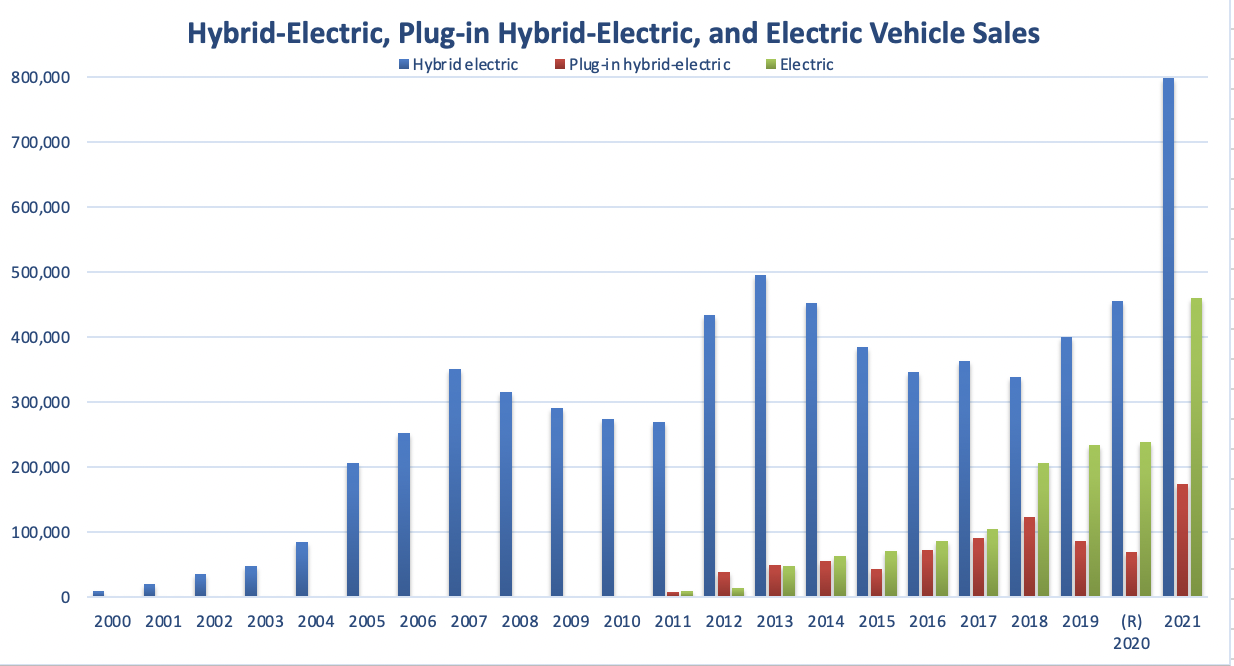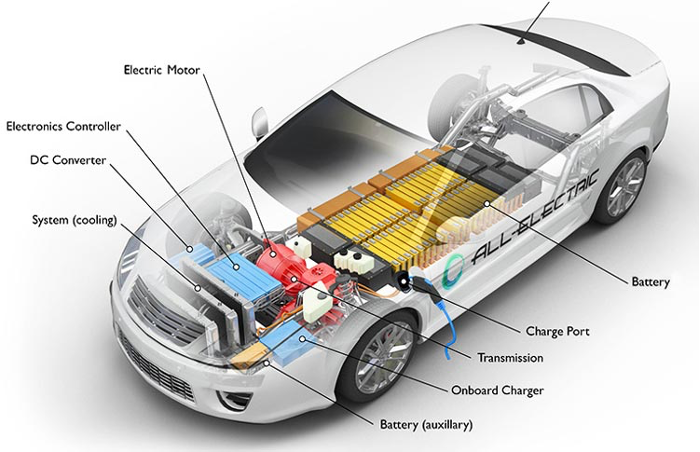According to the U.S. Bureau of Transportation Statistics, electric vehicle (EV) sales in the U.S. reached record high monthly volume in March 2021 and continued to rise, nearly doubling in 2021. This marks the sixth consecutive year of growth in electric vehicle (EV) sales and the demand is continuing to grow.
As production ramps up, it’s clear that EVs present a number of unique challenges, including greater susceptibility to electromagnetic interference (EMI). EVs employ high-power electronics to operate the electrical engine, producing high-level, low-frequency EMI. Interference is a common problem across electronics applications, but when we consider EV applications, where safety, efficiency, and performance rely on electronics, high levels of EMI could cause dangerous complications.

Figure 1: While hybrid electric vehicles (HEVs) were first on the market, electric vehicles (EVs) have quickly exploded in popularity. Source: Bureau of Transportation Statistics.
Looking at the composition of an EV, there are a number of sources of EMI (Figure 2) including the following:
- Power Converters are a primary source of EMI within electric drive systems; these systems require high-speed switching devices, like conventional insulated-gate bipolar transistors (IGBTs), to work at frequencies ranging from 2 to 20 kHz. Fast IGBTs and Silicon Carbide (SiC) metal–oxide–semiconductor field-effect transistors (MOSFETs) can work at even higher frequencies.
- Electric Motors operate at high power levels, causing electromagnetic emissions (EME) and offering a path for EMI via impedance, which changes as a function of frequency.
- The currents in traction batteries and interconnectors become a source of electric and magnetic field (EMF) emission, creating a path for EMI.
- Shielded and unshielded cables carry high levels of current between subsystems of an EV and cause stronger magnetic fields. With limited space for wiring, high- and low-voltage cables are placed in close proximity, causing EMI between them.
- Battery chargers and the wireless charging facilities are major external EMI sources; connecting to a wireless charger creates a strong magnetic field to transfer power to the EV.

Figure 2: Sources of EMI in EVs via Circuit Digest
What about Wide Band Gap Semiconductors?
Wide Band Gap (WBG) semiconductors, like SiC and Gallium Nitride (GaN), are effective in terms of power and efficiency, but there are EMI implications associated with increased switching frequencies. SiC-based devices accommodate smaller passive EMI filters, but EMI tends to concentrate in the high frequency range. Non-ideal behaviors in passive components at high frequencies could make filter design a challenge. Adjusting the filter scheme to reduce inductance/capacitance values and filter size is another means of reducing EPC and the equivalent series inductance (ESL), if needed. There are many other ways to address this trend in design, but it’s worth being aware of.
Capacitors for EMI in EV
In EV applications, filter capacitors, also known as EMI filters, are commonly used as input and output capacitors. They act to remove noise and other unwanted signals on the line. On the high voltage alternating current (AC) side of a system, the capacitors typically provide EMI filtering, whereas on the direct current (DC) side of a subsystem, they serve to smooth ripple components of the AC and filter out noise.
There’s a wide variety of EMI filtering options to meet a range of application demands. Introduction to EMI Filtering and Insertion Loss and Performance in EMI Filtering offer foundational context if you need a refresher on EMI and the importance of filter choice. For example, if you’re working with a high reliability application, you might need safety-certified Class X and Class Y capacitors. A Class X (line-to-line) capacitor is designed to fail short, so when an overvoltage event occurs, the failure causes an overcurrent protective device (OCPD) to open, preventing an electric shock hazard. Class Y capacitors (line-to-ground) are also designed to fail open in the event ground connection is lost. A failure might be noisy, but it won’t be fatal.
High-voltage EV subsystems are highly scrutinized for reliability and safety, so Class X and Class Y multilayer ceramic capacitors (MLCCs) are a good fit since they comply with UL, TÜV, CSA, and other international safety specifications. These Class X and Class Y capacitors are most commonly available as ceramic or plastic film RFI/EMI suppression capacitors, but since some EV subsystems have high temperature and small size requirements, MLCCs are the only viable option that won’t melt in harsh operating conditions.
With our new expanded range of enhanced MLCCs, Knowles Precision Devices now offers a unique combination of capability and safety certification for electronic device applications like the components used in EVs. These new surface-mount MLCCs comply with international UL60384-14 and EN60384-14 specifications and can be used instead of leaded film capacitors in AC-DC power supplies. These MLCCs also meet class Y2/X1, X1, and X2 requirements as determined by the IEC-60384-14 standard; within these subclasses, we now offer four separate families of MLCCs.
Learn more about using our new line of safety-certified MLCCs in your EV applications.

